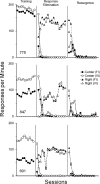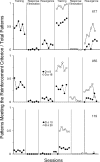Resurgence of temporal patterns of responding
- PMID: 21547067
- PMCID: PMC3088073
- DOI: 10.1901/jeab.2011.95-271
Resurgence of temporal patterns of responding
Abstract
The resurgence of temporal patterns of key pecking by pigeons was investigated in two experiments. In Experiment 1, positively accelerated and linear patterns of responding were established on one key under a discrete-trial multiple fixed-interval variable-interval schedule. Subsequently, only responses on a second key produced reinforcers according to a variable-interval schedule. When reinforcement on the second key was discontinued, positively accelerated and linear response patterns resurged on the first key, in the presence of the stimuli previously correlated with the fixed- and variable-interval schedules, respectively. In Experiment 2, resurgence was assessed after temporal patterns were directly reinforced. Initially, responding was reinforced if it approximated an algorithm-defined temporal pattern during trials. Subsequently, reinforcement depended on pausing during trials and, when it was discontinued, resurgence of previously reinforced patterns occurred for each pigeon and for 2 of 3 pigeons during a replication. The results of both experiments demonstrate the resurgence of temporally organized responding and replicate and extend previous findings on resurgence of discrete responses and spatial response sequences.
Keywords: behavioral history; discrete-trial procedure; key peck; pigeons; resurgence; temporal patterns of responding.
Figures









Similar articles
-
Resurgence during transitions from variable- to fixed-interval schedules.Behav Processes. 2022 Feb;195:104567. doi: 10.1016/j.beproc.2021.104567. Epub 2021 Dec 17. Behav Processes. 2022. PMID: 34929305
-
Differential resurgence and response elimination.Behav Processes. 2007 Jun;75(2):115-28. doi: 10.1016/j.beproc.2007.02.025. Epub 2007 Mar 3. Behav Processes. 2007. PMID: 17395402
-
Response elimination, reinforcement rate and resurgence of operant behavior.Behav Processes. 2013 Nov;100:91-102. doi: 10.1016/j.beproc.2013.07.027. Epub 2013 Aug 14. Behav Processes. 2013. PMID: 23954832
-
Resurgence without overall worsening of alternative reinforcement.Behav Processes. 2020 Oct;179:104219. doi: 10.1016/j.beproc.2020.104219. Epub 2020 Aug 7. Behav Processes. 2020. PMID: 32777262
-
Dynamic Interactions between Induction and Reinforcement in the Organization of Behavior.Perspect Behav Sci. 2025 Jun 3;48(2):315-339. doi: 10.1007/s40614-025-00453-5. eCollection 2025 Jun. Perspect Behav Sci. 2025. PMID: 40520580 Free PMC article. Review.
Cited by
-
Changes in the elimination and resurgence of alcohol-maintained behavior in rats and the effects of naltrexone.Psychol Addict Behav. 2020 Feb;34(1):10-22. doi: 10.1037/adb0000525. Epub 2019 Nov 21. Psychol Addict Behav. 2020. PMID: 31750701 Free PMC article.
-
Factors that encourage generalization from extinction to test reduce resurgence of an extinguished operant response.J Exp Anal Behav. 2018 Jul;110(1):11-23. doi: 10.1002/jeab.446. Epub 2018 Jun 17. J Exp Anal Behav. 2018. PMID: 29911341 Free PMC article.
-
Why behavior change is difficult to sustain.Prev Med. 2014 Nov;68:29-36. doi: 10.1016/j.ypmed.2014.06.010. Epub 2014 Jun 15. Prev Med. 2014. PMID: 24937649 Free PMC article. Review.
-
Quantitative analysis of local-level resurgence.Learn Behav. 2017 Mar;45(1):76-88. doi: 10.3758/s13420-016-0242-1. Learn Behav. 2017. PMID: 27495929
-
Behavioral momentum theory fails to account for the effects of reinforcement rate on resurgence.J Exp Anal Behav. 2016 May;105(3):375-92. doi: 10.1002/jeab.207. J Exp Anal Behav. 2016. PMID: 27193242 Free PMC article.
References
-
- Carey J.P. Reinstatement of previously learned responses under conditions of extinction: A study of “regression” [Abstract] American Psychologist. 1951;6:284.
-
- Carey J.P. Reinstatement of learned responses under conditions of extinction: A study of regression. 1953. Unpublished doctoral dissertation, Columbia University.
Publication types
MeSH terms
LinkOut - more resources
Full Text Sources

